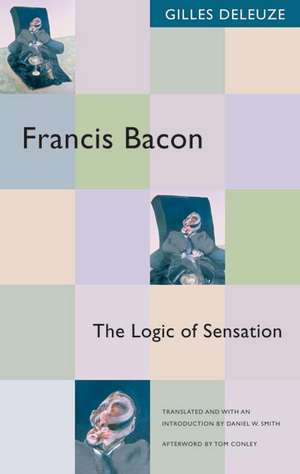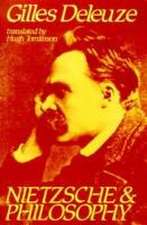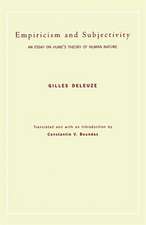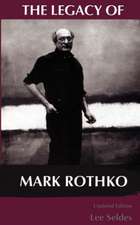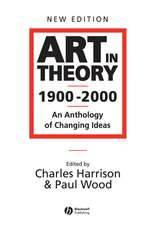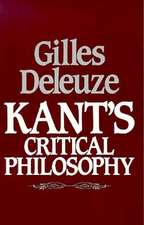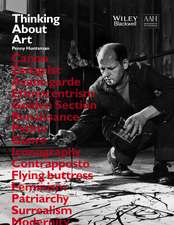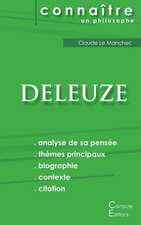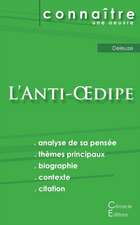Francis Bacon: The Logic of Sensation
Autor Gilles Deleuzeen Limba Engleză Paperback – 25 mai 2005
Translated and with an Introduction by Daniel W. Smith
Afterword by Tom Conley
Gilles Deleuze had several paintings by Francis Bacon hanging in his Paris apartment, and the painter’s method and style as well as his motifs of seriality, difference, and repetition influenced Deleuze’s work. This first English translation shows us one of the most original and important French philosophers of the twentieth century in intimate confrontation with one of that century’s most original and important painters.
In considering Bacon, Deleuze offers implicit and explicit insights into the origins and development of his own philosophical and aesthetic ideas, ideas that represent a turning point in his intellectual trajectory. First published in French in 1981, Francis Bacon has come to be recognized as one of Deleuze’s most significant texts in aesthetics. Anticipating his work on cinema, the baroque, and literary criticism, the book can be read not only as a study of Bacon’s paintings but also as a crucial text within Deleuze’s broader philosophy of art.
In it, Deleuze creates a series of philosophical concepts, each of which relates to a particular aspect of Bacon’s paintings but at the same time finds a place in the “general logic of sensation.” Illuminating Bacon’s paintings, the nonrational logic of sensation, and the act of painting itself, this work—presented in lucid and nuanced translation—also points beyond painting toward connections with other arts such as music, cinema, and literature. Francis Bacon is an indispensable entry point into the conceptual proliferation of Deleuze’s philosophy as a whole.
Gilles Deleuze (1925–1995) was professor of philosophy at the University of Paris, Vincennes–St. Denis. He coauthored Anti-Oedipus and A Thousand Plateaus with Félix Guattari. These works, as well as Cinema 1, Cinema 2, The Fold, Proust and Signs, and others, are published in English by Minnesota.
Daniel W. Smith teaches in the Department of Philosophy at Purdue University.
Afterword by Tom Conley
Gilles Deleuze had several paintings by Francis Bacon hanging in his Paris apartment, and the painter’s method and style as well as his motifs of seriality, difference, and repetition influenced Deleuze’s work. This first English translation shows us one of the most original and important French philosophers of the twentieth century in intimate confrontation with one of that century’s most original and important painters.
In considering Bacon, Deleuze offers implicit and explicit insights into the origins and development of his own philosophical and aesthetic ideas, ideas that represent a turning point in his intellectual trajectory. First published in French in 1981, Francis Bacon has come to be recognized as one of Deleuze’s most significant texts in aesthetics. Anticipating his work on cinema, the baroque, and literary criticism, the book can be read not only as a study of Bacon’s paintings but also as a crucial text within Deleuze’s broader philosophy of art.
In it, Deleuze creates a series of philosophical concepts, each of which relates to a particular aspect of Bacon’s paintings but at the same time finds a place in the “general logic of sensation.” Illuminating Bacon’s paintings, the nonrational logic of sensation, and the act of painting itself, this work—presented in lucid and nuanced translation—also points beyond painting toward connections with other arts such as music, cinema, and literature. Francis Bacon is an indispensable entry point into the conceptual proliferation of Deleuze’s philosophy as a whole.
Gilles Deleuze (1925–1995) was professor of philosophy at the University of Paris, Vincennes–St. Denis. He coauthored Anti-Oedipus and A Thousand Plateaus with Félix Guattari. These works, as well as Cinema 1, Cinema 2, The Fold, Proust and Signs, and others, are published in English by Minnesota.
Daniel W. Smith teaches in the Department of Philosophy at Purdue University.
| Toate formatele și edițiile | Preț | Express |
|---|---|---|
| Paperback (2) | 125.75 lei 24 ore | |
| Bloomsbury Publishing – 18 oct 2017 | 125.75 lei 24 ore | |
| University of Minnesota Press – 25 mai 2005 | 139.34 lei 3-5 săpt. | +11.40 lei 6-10 zile |
| Hardback (1) | 531.96 lei 6-8 săpt. | |
| Bloomsbury Publishing – 21 apr 2003 | 531.96 lei 6-8 săpt. |
Preț: 139.34 lei
Nou
Puncte Express: 209
Preț estimativ în valută:
26.67€ • 28.96$ • 22.40£
26.67€ • 28.96$ • 22.40£
Carte disponibilă
Livrare economică 02-16 aprilie
Livrare express 18-22 martie pentru 21.39 lei
Preluare comenzi: 021 569.72.76
Specificații
ISBN-13: 9780816643424
ISBN-10: 0816643423
Pagini: 224
Ilustrații: none
Dimensiuni: 138 x 216 x 18 mm
Greutate: 0.28 kg
Ediția:First edition
Editura: University of Minnesota Press
Colecția Univ Of Minnesota Press
ISBN-10: 0816643423
Pagini: 224
Ilustrații: none
Dimensiuni: 138 x 216 x 18 mm
Greutate: 0.28 kg
Ediția:First edition
Editura: University of Minnesota Press
Colecția Univ Of Minnesota Press
Caracteristici
Introduces some of Deleuze's best known concepts such as 'body without organs' and the 'diagram'.
Notă biografică
Gilles Deleuze (1925-1995) was one of the key figures in poststructuralism, and one of the most influential philosophers of the 20th century. His major works include, with Felix Guattari, A Thousand Plateaus and Anti-Oedipus, also published in the Bloomsbury Revelations series.
Cuprins
Translator's Preface, by Daniel W. Smith Preface to the French Edition, by Alain Badiou and Barbara Cassin Author's Foreword Author's Preface to the English Edition1. The Round Area, the RingThe round area and its analogues - Distinction between the Figure and the figurative - The fact - The question of "matters of fact" - The three elements of painting: structure, Figure, and contour - Role of the fields2. Note on Figuration in Past PaintingPainting, religion, and photography - On two misconceptions3. Athleticism First movement: from the structure to the Figure - Isolation - Athleticism - Second movement: from the Figure to the structure - The body escapes from itself: abjection - Contraction, dissipation: washbasins, umbrellas, and mirrors4. Body, Meat, and Spirit, Becoming-AnimalMan and animal - The zone of indiscernibility - Flesh and bone: the meat descends from the bone - Pity - Head, face, and meat5. Recapitulative Note: Bacon's Periods and AspectsFrom the scream to the smile: dissipation - Bacon's three successive periods - The coexistence of all the movements - The functions of the contour6. Painting and SensationCezanne and sensation - The levels of sensation - Figuration and violence - The movement of translation, the stroll - The phenomenological unity of the senses: sensation and rhythm7. HysteriaThe body without organs: Artaud - Worringer's Gothic line - What the "difference of level" in sensation means - Vibration - Hysteria and presence - Bacon's doubt - Hysteria, painting, and the eye8. Painting ForcesRendering the invisible: the problem of painting - Deformation: neither transformation nor decomposition - The scream - Bacon's love of life - Enumeration of forces9. Couples and TriptychsCoupled Figures - The battle and the coupling of sensation - Resonance - Rhythmic Figures - Amplitude and the three rhythms - Two types of "matters of fact"10. Note: What Is a Triptych?The attendant - The active and the passive - The fall: the active reality of the difference in level - Light, union and separation11. The Painting before Painting .. .Cezanne and the fight against the cliche - Bacon and photographs - Bacon and probabilities - Theory of chance: accidental marks - The visual and the manual - The status of the figurative12. The DiagramThe diagram in Bacon (traits and color-patches) - Its manual character - Painting and the experience of catastrophe - Abstract painting, code, and optical space - Action Painting, diagram, and manualspace - What Bacon dislikes about both these ways13. Analogy Cezanne: the motif as diagram - The analogical and the digital - Painting and analogy - Theparadoxical status of abstract painting - The analogical language of Cezanne and of Bacon: plane, color, and mass - Modulation - Resemblance recovered14. Every Painter Recapitulates the History of Painting in His or Her Own Way .. .Egypt and haptic presentation - Essence and accident - Organic representation and the tactileoptical world - Byzantine art: a pure optical world? - Gothic art and the manual - Light and color, the optic and the haptic15. Bacon's PathThe haptic world and its avatars - Colorism - A new modulation - From Van Gogh and Gauguin to Bacon - The two aspects of color: bright tone and broken tone, field and Figure, shores and flows .. .16. Note on ColorColor and the three elements of painting - Color-structure: the fields and their divisions - The role of black Color-force: Figures, flows, and broken tones Heads and shadows - Color-contour - Painting and taste: goodand bad taste17. The Eye and the Hand Digital, tactile, manual, and haptic - The practice of the diagram - On "completely different" relations - Michelangelo: the pictorial factIndex of Paintings Notes Index
Recenzii
A lively and systematic study of Bacon's work. The book is clearly organised, helping to make complicated arguments easier to follow.
A path-breaking work on the aesthetics of sensation, the philosophy of colour, on form, and on painting in general, Francis Bacon is one of the most important, if not the most crucial, of all of Deleuze's writings.
One of Deleuze's most beautifully crafted studies, and an essential component of his aesthetic philosophy.
Art historians as well as scholars of 20th century intellectual history will find this a rich mine of original thought.
Long-awaited. This book is invaluable for an understanding of the trajectory of Deleuze's own thought. Offers an entry point into Deleuze's more explicitly theoretical work that simultaneously grounds and orients that theory in terms of a specific instance.
A path-breaking work on the aesthetics of sensation, the philosophy of colour, on form, and on painting in general, Francis Bacon is one of the most important, if not the most crucial, of all of Deleuze's writings.
One of Deleuze's most beautifully crafted studies, and an essential component of his aesthetic philosophy.
Art historians as well as scholars of 20th century intellectual history will find this a rich mine of original thought.
Long-awaited. This book is invaluable for an understanding of the trajectory of Deleuze's own thought. Offers an entry point into Deleuze's more explicitly theoretical work that simultaneously grounds and orients that theory in terms of a specific instance.
